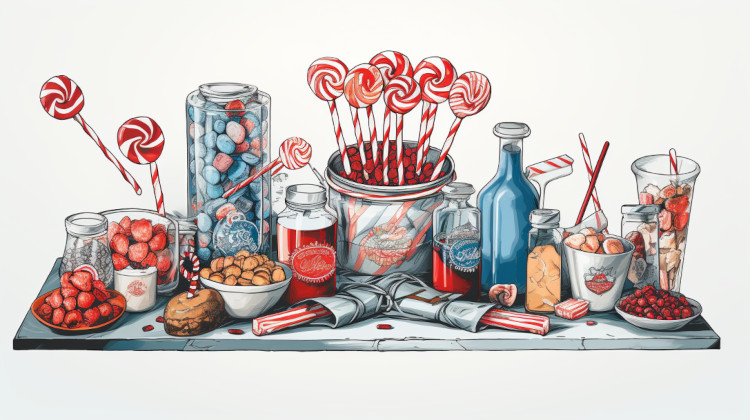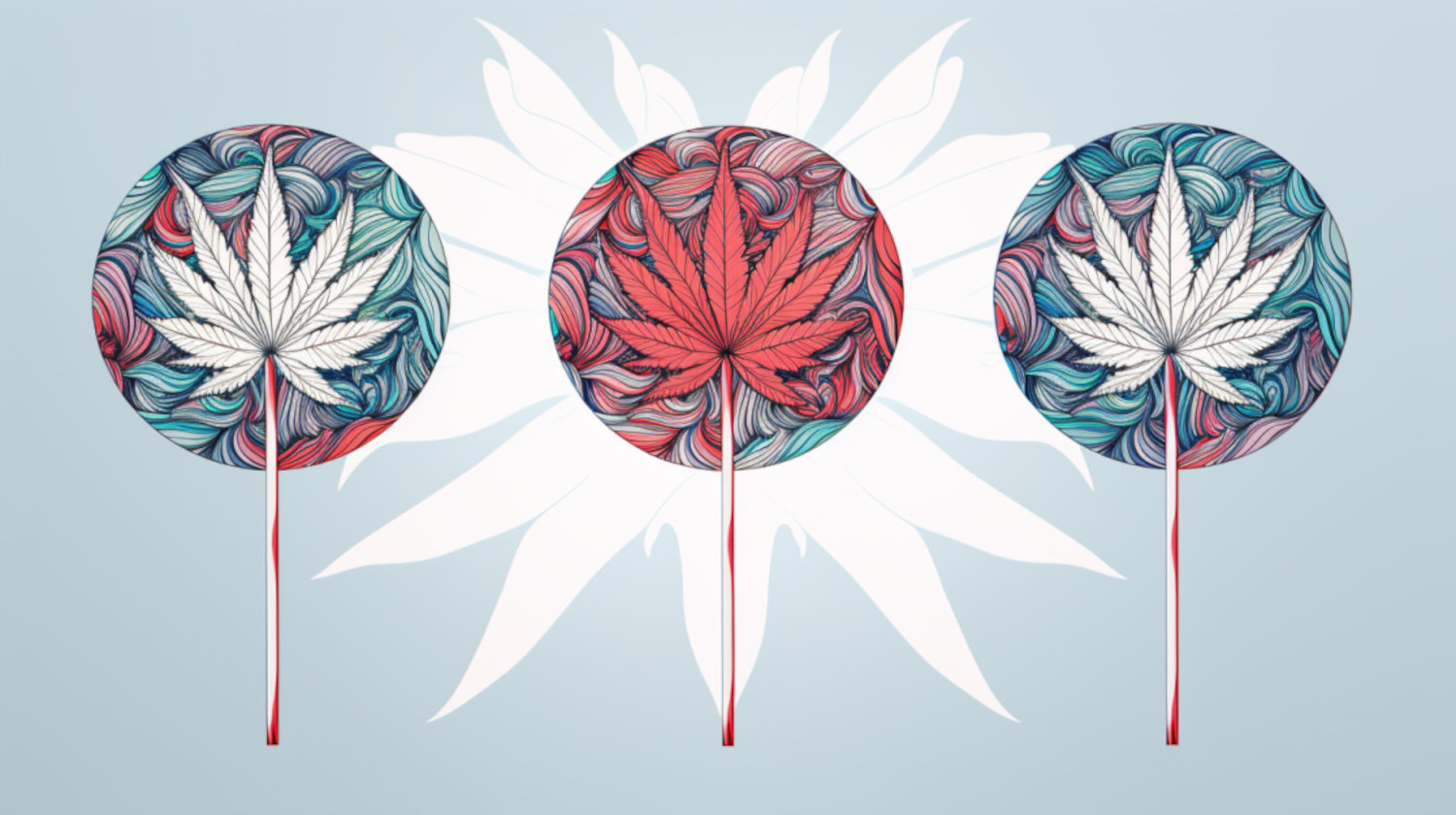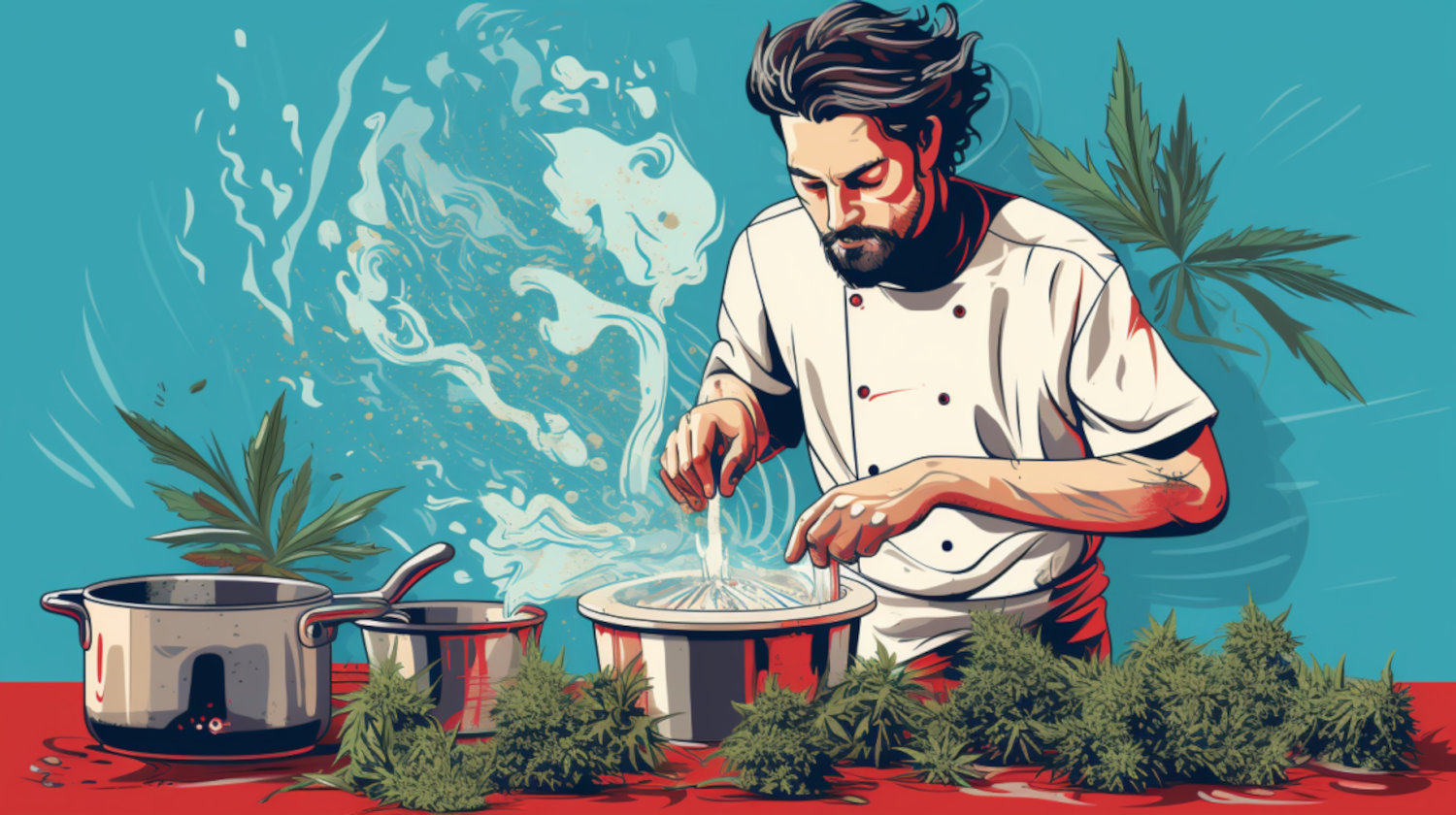In This Article
- What Types of Weed Candy Are There?
- What You'll Need to Make Candy Edibles
- Equipment
- Ingredients
- Choosing the Right Cannabis Strain
- Tips for Special Dietary Needs
- The First Step: Decarb the Weed
- What Is Decarboxylation?
- A Quick Overview of the Decarb Process
- Why Is Decarbing Important for Candies?
- How to Make Weed Hard Candy and Lollipops
- Ingredients
- Instructions
- Dietary Variations
- How to Store Weed Candy
- Factors to Consider
- Steps for Proper Storage
- Shelf Life
- Savoring the Experience
Key Takeaways
- Cannabis candies are a discreet, flavorful way to enjoy edibles, with many options you can make at home.
- Decarboxylation is essential for activating THC or CBD in candy-making.
- Decarb the weed > Infuse into coconut oil > Mix the ingredients, and heat in a saucepan > Don’t let it get above 300°F > Mix in cannabis and flavors > Pour into molds > Cool.
Gummies often come to mind when we think of candy edibles, thanks to their wide popularity. Yet, the candy universe is vast, comprising many different types of edibles. With a little creativity and the right ingredients, you can craft a myriad of delectable cannabis treats right in your kitchen.
Whether you're looking for a new way to consume your favorite cultivar or just want to try your hand at candy-making, this article guides you through how to make weed candy at home without any hassle.
What Types of Weed Candy Are There?
Cannabis-infused candies offer a flavorful and discreet alternative to traditional consumption methods, which may be why some prefer them over smoking or baked edibles.
Cannabis candies cater to a wide range of preferences and tastes with various flavors, potencies, and forms. Let’s explore some of the most popular ones and why they are popular.
- Gummies: Weed gummies are likely the first candy that comes to mind. These popular candies are colorful and chewy and come in an array of flavors, from sour to sweet. They offer precise dosages and a long shelf life.
- Hard Candies: These are similar to your typical store-bought hard candy but infused with cannabis. They're discreet, easy to consume, and can be formulated with various flavors, such as lemon, cherry, or mint.
- Lozenges: These are small, hard candies that dissolve slowly in the mouth. Cannabis lozenges can offer a more extended, more sustained release of cannabinoids, similar to lollipops, but without the stick.
- Lollipops: Cannabis-infused lollipops are a classic candy reimagined. They are fun, convenient, and provide a prolonged release of cannabinoids as they're slowly savored.
- Chocolate Bars: While not strictly candy, cannabis-infused chocolate bars have found their way into the hearts of many. From dark to white chocolate, with various added ingredients like nuts or dried fruits, there's a flavor profile for everyone.
- Caramels and Toffees: These candies are soft, chewy, and melt-in-the-mouth, providing a luxurious way to enjoy cannabis. The richness of caramel combined with the depth of cannabis creates an incomparable taste experience.
- Jelly Candies: These are a firmer version of gummies coated with sugar. They have a distinct texture and are another fan favorite.
- Marshmallows: Some brands or DIY recipes offer cannabis-infused marshmallows, which can be eaten on their own or used in other dessert preparations.
- Fruit Chews or Taffy: These chewy candies come in various fruit flavors and can be similar in texture to some taffies.
- Mints: These are smaller, often discreet edibles that can be taken similarly to regular breath mints but offer the effects of cannabis.
So, why have these candy edibles gained such traction? For many, it boils down to three main reasons:
- Discretion and Convenience: Edible candies are smoke-free and scent-free. They're also portable and require no additional equipment, making them perfect for on-the-go consumption.
- Unique Experience: Cannabis edibles tend to produce longer-lasting effects than inhalation, which some consumers may find beneficial for certain needs or preferences.
- Avoiding Lung Health Risks: There's growing awareness about the potential harmful effects of smoking. Cannabis candies prevent this by providing an alternative way to consume without the toxins associated with combustion.
The allure of cannabis candy lies not just in its taste but also in its versatility, convenience, and the unique experience it offers. Whether you prefer the chewy delight of gummies or the rich flavor of caramels, there's a cannabis candy out there for you. And if you're curious about making some of these at home, stay tuned for our DIY recipes!
What You'll Need to Make Candy Edibles

Creating your very own cannabis candy is an exciting adventure that’s accessible for any skill level. Whether you're whipping up a batch of hard candies or crafting luscious lollipops, having the right tools and ingredients is crucial. Here's a comprehensive list to set you on the path to candy-making success:
Equipment
- Candy Thermometer: This ensures your candy mix reaches the right temperature.
- Saucepan: A heavy-bottomed saucepan helps in even heat distribution.
- Silicone Candy Molds: These make shaping your candies a breeze. They come in various shapes and sizes, from classic circles to fun, thematic designs.
- Lollipop Sticks: If you're making lollipops, these are a must.
- Stirring Spoon: Preferably, they should be silicone or wooden to ensure they remain cool during stirring and to avoid potential reactions or scratching the saucepan.
- Measuring Cups and Spoons: These are a must for accurate measurements.
- Parchment Paper or Silicone Baking Mats: These are useful for placing candies that don’t use molds.
Ingredients
- Cannabis: Depending on your preference, this could be cannabis flower, cannabis butter (cannabutter), cannabis coconut oil, or a cannabis tincture. Ensure your cannabis is decarboxylated to activate the cannabinoids.
- Sugar: Sugar is the primary sweetener for most candies.
- Corn Syrup: Depending on the candy you're making, corn syrup can help achieve the desired consistency.
- Water: It's mostly used to dissolve sugar and other ingredients, evaporating during boiling to achieve the desired candy consistency.
- Flavoring: This can be natural extracts like vanilla, mint, or fruit flavors.
- Coloring: Food-safe coloring agents give your candies that vibrant look.
- Citric Acid (optional): If you're aiming for a sour kick, citric acid or just citrus juice can work.
- Cream or Milk (for caramels and toffees): They provide a creamy texture for certain confections.
Choosing the Right Cannabis Strain
It’s commonly believed that different cultivars will result in different edible flavors and effects. But this may not be true for many homemade dishes.
First, traditional classifications like “indica” and “sativa” can be somewhat outdated and may not accurately represent the effects of every cultivar within these categories. The effects of cannabis can vary significantly based on an individual's biology, tolerance, the specific terpene profile of the cultivar, along with other factors.
Speaking of terpenes, it’s not uncommon for these aromatic compounds to burn off during decarboxylation due to their very low boiling point. It’s still worth selecting your preferred cultivar when making weed candy at home, but for many dishes and cooking methods, the potency and quantity often play a larger role in the final outcome than strain selection, especially when terpenes degrade during cooking.
Tips for Special Dietary Needs
- Gluten-Free: Ensure all ingredients, especially flavorings and colorings, are gluten-free.
- Vegan: Use cannabis-infused coconut oil or a cannabis tincture instead of cannabutter. Avoid recipes that call for milk or cream. You might be able to substitute plant-based milk for some recipes. Be sure you are using organic cane sugar or sugar from another source that is not processed with bone char, like beet sugar.
- Allergy-Sensitive: Always be sure to check the labels for potential allergens and adjust recipes accordingly.
With all these tools and ingredients, you're ready to start making delicious cannabis candies. As with all edibles, it’s best to start with a low dose, especially if you’re new to edibles. Ideally, wait at least an hour or more to assess how you feel before consuming more. Happy candy-making!
The First Step: Decarb the Weed
Before making cannabis candies, there's a critical step that can't be missed: decarboxylation. Cannabis consumers often refer to this process as "decarbing," and it's the key to unlocking the full potential of your cannabis, ensuring that the intoxicating effects are activated for full potency.
What Is Decarboxylation?
In its natural state, cannabis contains THCA (tetrahydrocannabinolic acid) and CBDA (cannabidiolic acid), the non-intoxicating precursors to THC and CBD, respectively. Decarbing is the process of heating these compounds, converting THCA into THC and CBDA into CBD.
A Quick Overview of the Decarb Process
- Preparation: Begin by breaking your cannabis buds into smaller pieces but not too fine. A coarse grind is ideal.
- Preheat: Set your oven to around 240°F (115°C). Ovens can vary, so using an oven thermometer to verify the temperature can be helpful.
- Spread Evenly: Place your cannabis pieces on a parchment paper-lined baking sheet, spreading the cannabis evenly to guarantee uniform heat exposure. If you're unsure of how much cannabis to use, an edible calculator can help you dial in the dose.
- Bake: Insert the baking sheet into the preheated oven. The decarbing time will differ depending on the desired cannabinoids. For THC, aim for approximately 40 minutes, while for CBD, a slightly longer time, around 60 minutes, may be required.
- Cool and Store: Once decarbed, remove the cannabis from the oven and let it cool. It should be darker in color and crumbly to the touch. Store it in an airtight container until it's time to infuse your candy mixture.
Why Is Decarbing Important for Candies?
Unlike cannabis-infused baked goods that undergo some degree of decarboxylation while baking, candies are made using methods that don't always ensure complete decarboxylation due to varying temperatures and durations. Therefore, it's essential to decarb your cannabis separately before introducing it into your candy recipe to ensure effectiveness.
How to Make Weed Hard Candy and Lollipops

Crafting your very own cannabis-infused hard candies and lollipops is an easy and enjoyable experience. Both treats follow a similar process, with just a slight variation when it comes to shaping. Below is a straightforward guide to help you make mouthwatering cannabis candies that many find enjoyable to make and share responsibly.
Ingredients
- 1 cup granulated sugar
- 1/2 cup corn syrup
- 1/4 cup water
- 7-14 grams of cannabis flower (decided based on desired potency) or a suitable amount of cannabis tincture or infused coconut oil
- 1-2 teaspoons flavoring (like mint, citrus, berry, or any of your choice)
- Food coloring (optional for added visual appeal)
- Citric acid (optional for a sour twist)
Instructions
- Decarb Your Cannabis: If using cannabis flower, decarboxylate it first by following the decarb process mentioned in previous sections.
- Infuse the Cannabis: If using decarbed cannabis flower, you'll need to infuse it into your choice of fat (like coconut oil or butter). Simmer the decarbed cannabis with your fat of choice on low heat for a few hours. Strain the mixture to remove the plant material. Measure out the desired amount of infused oil. As an alternative, you can use prepared or homemade cannabis tincture.
- Prepare Your Tools: Ensure your candy thermometer, silicone molds (or parchment paper), and lollipop sticks (if making lollipops) are ready.
- Mix Base Ingredients: Combine sugar, corn syrup, and water in a heavy-bottomed saucepan over medium heat. Stir the mixture until the sugar fully dissolves.
- Monitor Temperature: Insert the candy thermometer into your saucepan. Let the mixture boil without stirring until it reaches the 'hard crack' stage (around 300°F or 150°C). It's crucial not to let it boil past this point, as it could lead to burnt candy.
- Add Cannabis and Flavors: Once you reach the proper temperature, remove the saucepan from the heat. Wait for bubbles to subside, then carefully stir in your cannabis tincture or infused oil, flavoring, and food coloring, if using. If you're aiming for sour candies, this is the time to add citric acid.
- Shape Your Candies: Carefully pour the mixture into silicone molds for hard candies. If making lollipops, place lollipop sticks on a silicone mat or parchment paper and pour the mixture around the stick, ensuring it's in the center. Act quickly, as the mixture will start to harden soon.
- Cool and Harden: Allow your candies to cool and harden at room temperature. This might take a few hours, but it's worth the wait!
- Unmold and Store: Once set, gently pop your candies out of the molds or lift them off the parchment paper—store in an airtight container, preferably with parchment paper between each candy to prevent sticking.
Dietary Variations
- Gluten-Free and Vegan: This basic recipe is naturally gluten-free and can be made vegan using cannabis-infused oil, tincture, and organic sugar.
- Allergy Considerations: Always ensure your flavorings and additional ingredients are free from allergens that you or your guests might be sensitive to.
Crafting cannabis-infused hard candies and lollipops at home allows you to customize flavors, potencies, and ingredients to your liking. When consuming edibles, start with a small piece to gauge its effects, especially if you're unsure of the potency. Enjoy your homemade confections responsibly!
How to Store Weed Candy
After investing time and care into creating your delicious cannabis-infused hard candies and lollipops, proper storage is crucial to maintain their potency, taste, and overall quality. Edibles, just like other food products, can degrade over time, especially when exposed to certain environmental conditions.
Here's a comprehensive guide on how to properly store your cannabis candy to ensure it remains as tasty and effective as the day you made it.
Factors to Consider
- Moisture: Candies can become sticky and might lose their shape if exposed to moisture.
- Light: Exposure to direct light, especially sunlight, can degrade THC, diminishing the candy's potency.
- Air: Oxygen can speed up the degradation process, which can affect the candy's taste and cannabinoid content.
- Heat: Prolonged exposure to high temperatures can change the consistency of your candies and reduce their potency.
Steps for Proper Storage
- Cool and Dry: Always store your candies in a cool, dry place. Humidity and heat can cause candies to become sticky and melt. A pantry or cupboard is often ideal.
- Air-Tight Containers: Store your candies in air-tight containers or resealable bags. This helps prevent air exposure, keeping your edibles fresher for longer.
- Parchment or Wax Paper: If you're stacking candies or worried about them sticking together, place a piece of wax or parchment paper between each candy. This prevents them from sticking together and makes them easier to handle.
- Avoid Direct Light: Store your candy containers in a dark place or use opaque containers. This shields them from light which can degrade cannabinoids.
- Labeling: If you've made candies of different potencies or flavors, it's a good idea to label the containers. This ensures you always know what you're consuming and helps others in your household stay informed.
- Refrigeration: While it's not always necessary if you live in a particularly humid or warm environment, consider refrigerating your candies. If doing so, make sure they are in a sealed container to prevent moisture and other food odors from affecting them.
Shelf Life
Cannabis Candy Lifespan: Properly stored cannabis candies can last for several months. However, it's essential to remember that the potency might decrease slightly over time.
- Hard Candies and Lollipops: These typically last the longest because they have low moisture content. When stored properly (in a cool, dark, and dry place), they can remain fresh and potent for 6-12 months. However, over time, the potency might still decrease slightly.
- Gummies or Chewy Candies: When stored in optimal conditions, these can last 4-6 months. Their chewy nature and higher moisture content make them more susceptible to mold and bacterial growth than hard candies.
- Candies with Dairy or Fresh Ingredients: If you've made candies with fresh ingredients, such as cream-filled chocolates or truffles, their shelf life will be significantly shorter, usually 2-4 weeks, and they might need refrigeration.
Signs of Degradation: If candies appear overly sticky, have an off odor, or show any signs of mold, it's best to discard them.
Cannabis-infused candies offer a unique and delightful way to consume cannabis. You can enjoy these treats at their best for an extended period by ensuring they are stored correctly. As always, consume responsibly, and keep edibles out of the reach of children and pets.
Savoring the Experience
Crafting cannabis-infused candies at home can be a rewarding way to explore the effects of cannabis in a format that’s both flavorful and customizable.
From understanding the variety of cannabis candies available to mastering the art of making them and ensuring their freshness, you're now ready to enjoy a sweeter side of cannabis.
The information in this article and any included images or charts are for educational purposes only. This information is neither a substitute for, nor does it replace, professional legal advice or medical advice, diagnosis, or treatment. If you have any concerns or questions about laws, regulations, or your health, you should always consult with an attorney, physician or other licensed professional.




